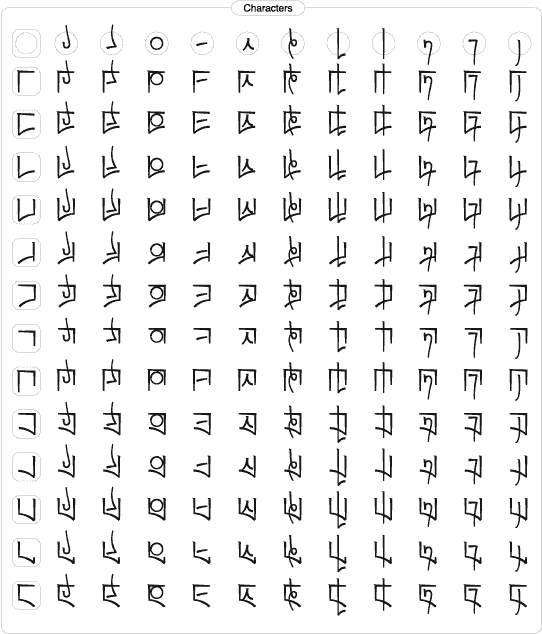Chumauni

Chumauni was initially inspired by the structure of Hangul and style
of Tibetan, with the idea of using a similarly regular structure and
composition to create a writing system in transition from syllabary to
alphabet. D. Jensen started the design for Chumauni in 2004 for a
project he has since abandoned, but completed the writing system in
2007 anyway.
Notable features
- Written in rows left to right, top to bottom.
- Each character is composed of two parts: a consonant and vowel symbol.
- There are 13 consonant symbols, 11 vowel symbols, and two placeholders.
- Most consonant symbols have design features in common when they share pronunciation traits.
- Vowel symbols are centred within the consonants and have design features in common.
- A diacritic can be appended to reverse the pronunciation of a character.
- Some words are separated by a space, others by a punctuation mark,
depending on the relationship between the words.
Chumauni consonants

Where consonants appear in pairs the left symbol represents its value
in a regular character at word-start, the right symbol represents its
value in other cases. The exception to this rule is [ɱ] which only
appears immediately prior to [f].
- Characters with this symbol are automatically reversed (vowel is
pronounced first) at word-start and when following a reversed character.
- Characters with this symbol cannot be reversed.
- Consonant placeholder; incompatible with reversal and repeat marks.
May not appear at word-start before a reversed character or next to
another consonant placeholder.
Chumauni vowels

Vowels fall into the following groups:
- High (H): i, aɪ, e/eɪ, æ/a
- Short (S): ɪ, ɛ, ə, ʊ
- Whole (W): u, o, c
When two vowels abut due to placeholders or a reversal, a [w] or [j]
sound is inserted between them according to the following vowel order
(H = High; S = Short; W = Whole): H[w]H, H[w]S, S[w]S, S[w]H, W[w]H;
H[j]W, S[j]W, W[j]W, W[j]S.
- Vowel placeholder; incompatible with reversal and repeat marks.
Characters with this placeholder may not appear at word-start, only at
the end of words, following a regular character, or when preceeding a
reversed character.
Chumauni characters

- Unless otherwise indicated (see Consonant footnotes and Diacritics),
character are pronounced consonant first, then vowel.
- Characters with placeholders not shown.
Chumauni diacritics and punctuation

- Reversal: reverses the pronunciation order for the affected
character. <'fo> would be pronounced /of/.
- Repeat: repeats the affected character. would be pronounced
/fofo/. Can be combined with reversal mark.
- Capital: designates the character as the start of a proper noun,
title (only the first word), honorific, paragraph or stanza. May be
combined with the repeat and reversal marks (placed above capital mark).
- Joiner: links adjectives to nouns, adverbs to verbs, honourifics to
names, numbers to units, and words within titles, ship names, etc. Also
separates numbers, see Numerals.
- Pause: followed by a space, it serves as a pause or break indicator
within a paragraph. This mark serves the same purposes as the comma,
colon, (etc) and period in most cases found in English. Also separates
decimal values, see Numerals.
- Full Stop: marks the end of a paragraph or stanza.
- Container: used in place of the pause markers to emphasize the
connection between the clauses it contains. Also indicates quotations.
Chumauni numerals

The counting system was originally base-4, having characteristics in
common with both Mayan and Roman numerals. The numerals for 5-7 and 9
were adapted from 1-3 for the decimal system. The numerals for 0, 4
and 8 are relics of an older system.
- The joiner mark separates values as follows: 100,000 is written as 10-00-00.
- Decimal values follow the pause marker.
If you have any questions about Chumauni, please contact D. Jensen at:
derekjensen@gmail.com
Constructed scripts for: Ainu |
Arabic |
Chinese languages |
Dutch |
English |
Hawaiian |
Hungarian |
Japanese |
Korean |
Lingala |
Malay & Indonesian |
Persian |
Tagalog / Filipino |
Russian |
Sanskrit |
Spanish |
Taino |
Turkish |
Vietnamese |
Welsh |
Other natural languages |
Colour-based scripts |
Tactile scripts |
Phonetic/universal scripts |
Constructed scripts for constructed languages |
Adaptations of existing alphabets |
Fictional alphabets |
Magical alphabets |
A-Z index |
How to submit a constructed script
[top]

You can support this site by Buying Me A Coffee, and if you like what you see on this page, you can use the buttons below to share it with people you know.

If you like this site and find it useful, you can support it by making a donation via PayPal or Patreon, or by contributing in other ways. Omniglot is how I make my living.
Note: all links on this site to Amazon.com , Amazon.co.uk
, Amazon.co.uk and Amazon.fr
and Amazon.fr are affiliate links. This means I earn a commission if you click on any of them and buy something. So by clicking on these links you can help to support this site.
are affiliate links. This means I earn a commission if you click on any of them and buy something. So by clicking on these links you can help to support this site.
[top]






, Amazon.co.uk
and Amazon.fr
are affiliate links. This means I earn a commission if you click on any of them and buy something. So by clicking on these links you can help to support this site.